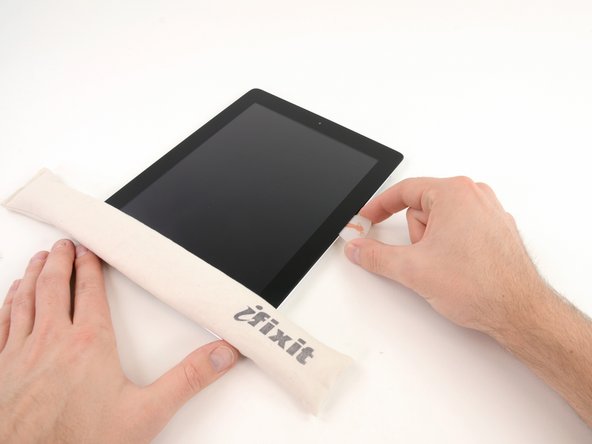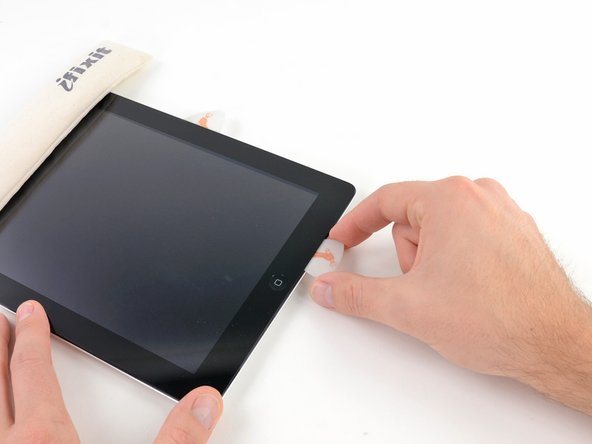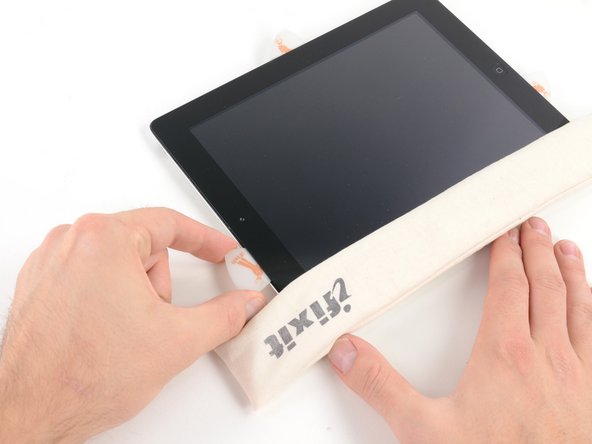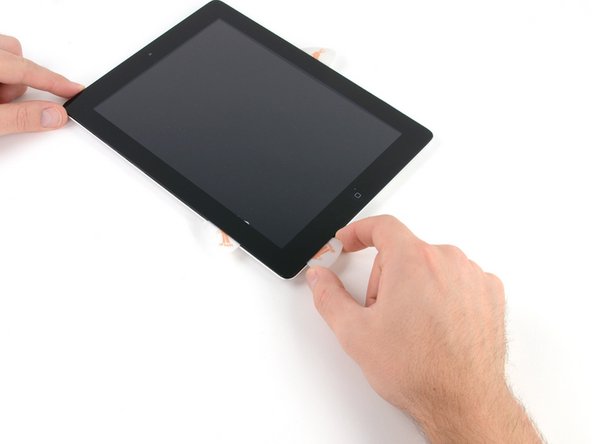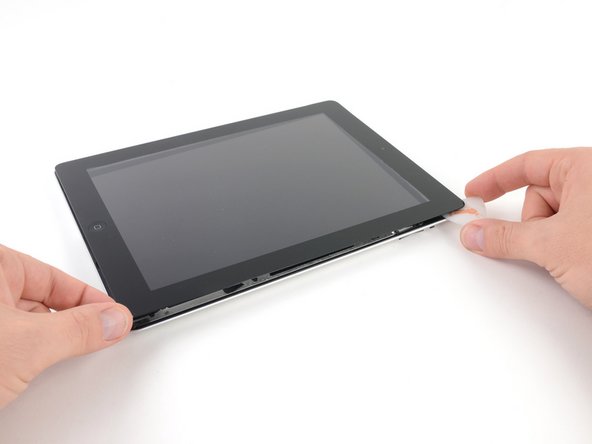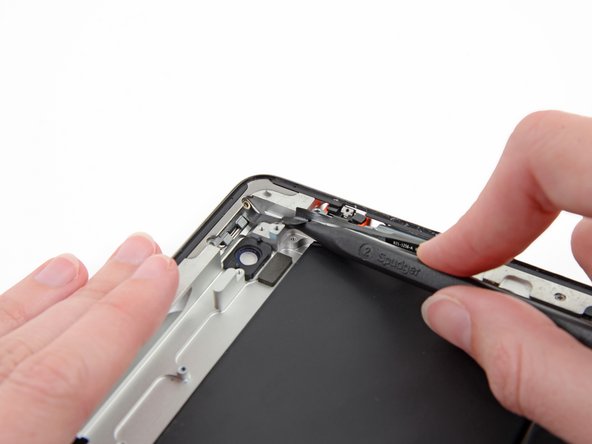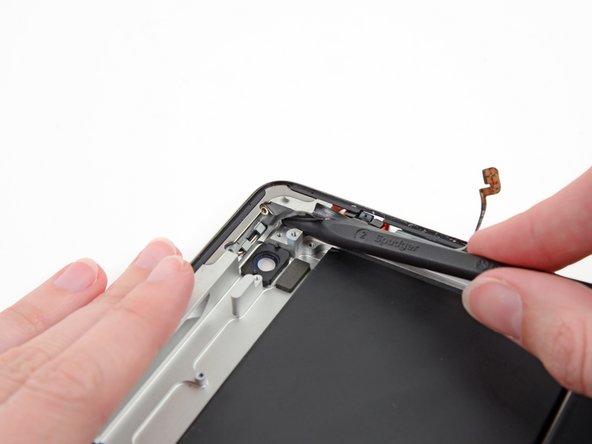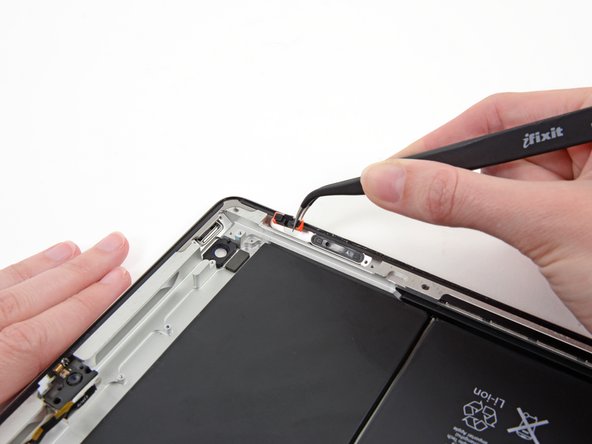DIY iPad Wi-Fi Rotation Lock Mute Switch Replacement Guide
Duration: 45 minutes
Steps: 60 Steps
Hey there! Just a quick heads-up: some steps might require a little extra patience and finesse. If you find yourself stuck or need a hand, don’t hesitate to schedule a repair. You’ve got this!
Follow this guide to swap out that rotation lock/mute switch with ease and style. Let’s get your device back in action without missing a beat! If you need help, you can always schedule a repair.
Step 1
Before you dive in, it’s a good idea to give your microwave a quick clean-up. That way, any pesky gunk hanging around won’t end up stuck to the iOpener. Trust us, your future self will thank you!
– Pop that iOpener right in the middle of the microwave and let it warm up!
Tools Used
Step 2
Keep an eye on that iOpener! Letting it get too hot can lead to a dramatic burst—definitely not the kind of action we want. Aim to keep it under 100˚C (212˚F).
If your iOpener looks like it’s been hitting the gym and is a bit swollen, give it some space!
If the middle of your iOpener is still too hot to handle, no worries! Just keep using it and let it chill for a bit longer before you reheat. A well-heated iOpener should stay cozy for about 10 minutes.
– Give your iOpener a cozy thirty-second warm-up in the microwave.
– As you tackle the repair, remember to pop that iOpener back in for another thirty seconds whenever it starts to cool down. Keep it toasty!
Tools Used
Step 3
The iOpener is going to be super toasty, so handle it with care! An oven mitt might just be your new best friend.
– Carefully take the iOpener out of the microwave, making sure to grip one of the flat ends to keep your fingers safe from the hot middle. Stay cool while you do this!
Tools Used
Step 4
If you’re not rocking a microwave, no worries! Just pop your iOpener into some boiling water to heat it up.
– Grab a pot or pan and fill it with enough water to completely dunk that iOpener.
– Get that water boiling and then turn off the heat. Safety first!
– Gently place the iOpener into the hot water and let it chill there for 2-3 minutes. Make sure it’s cozy and fully submerged!
– Using some tongs, carefully lift the warm iOpener out of the water. Watch out, it’s hot stuff!
– Give the iOpener a good dry with a towel, making sure it’s all set.
– And there you have it! Your iOpener is primed and ready to roll! If it needs a little more warmth, just repeat the boiling water dance for another 2-3 minutes.
Tools Used
Step 5
Put on those safety glasses to keep your peepers safe, and remember to handle that LCD screen with care—it’s more delicate than it looks!
– Got a cracked display glass? No worries! Keep things safe and sound by taping it up to avoid any further mishaps during your repair adventure.
– Grab some clear packing tape and lay down overlapping strips over the iPad’s display until it’s completely covered. It’s like giving your device a protective shield!
– Now, let’s dive into the rest of the guide! Just a heads up, once the glass starts cracking, it might keep on doing its thing as you work. You may need to bring out a metal prying tool to help scoop out the pieces. You’ve got this!
Step 6
Just a heads-up! While you’re tackling this repair, you might encounter some sharp glass edges. To keep your peepers safe from any unexpected flying bits, we suggest rocking a pair of safety glasses. Better safe than sorry, right?
– Place the iOpener gently on the right edge of the iPad, making sure it’s nice and flat so it can really connect with the surface of the iPad.
– Give the iOpener a cozy 90 seconds on the iPad before you dive into opening the front panel.
Tools Used
Step 7
Getting that snug tip of the opening tool between the glass and plastic might need a little elbow grease! Take your time and be gentle; wiggle the plastic tool back and forth as needed to make it work its magic.
– Spotting a tiny gap in the iPad’s adhesive ring? That’s your golden ticket! It’s located in the upper right corner, about 2.0 inches (~5 cm) from the top. Time to take advantage of this little flaw!
– Now, let’s get aligned! Position your tool right by the mute button. Gently slide the tip of a plastic opening tool into that gap between the front glass and the plastic bezel. Just a little nudge to widen the crack will do the trick!
Step 9
– With the tip of the plastic opening tool snugly between the front glass and plastic bezel, gently slide a plastic opening pick into the gap right alongside the tool. You’ve got this!
Step 10
– Take out that trusty plastic opening tool from your iPad, and gently slide the opening pick underneath the front glass, pushing it in about 0.5 inches. You’ve got this!
Step 12
The adhesive is super strong, so you might need to put in some elbow grease. Take your time and be gentle with it.
If you can spot the tip of the opening pick peeking out from under the front glass, gently pull it out a tad. While it’s totally safe to use the pick this deep, just a heads-up that it might leave some adhesive residue on the LCD. Keep it cool and carry on!
– As the iOpener warms up the bottom edge, start peeling back the adhesive from the right edge of your iPad.
– Gently slide the opening pick along the edge of the iPad, freeing that pesky adhesive as you go!
Tools Used
Step 13
As you peel away the adhesive, you might want to slide that cozy heated iOpener back over to the right edge of the iPad. How long it’s been cooling off while you’ve been working your magic will determine if this is necessary.
– If the opening pick is feeling a bit clingy in the adhesive, just give it a little roll along the edge of the iPad to help it break free. Keep on rolling to release that sticky stuff!
Tools Used
Step 14
– Before you pop that first opening pick from the bottom corner of your iPad, slide a second pick right under the right edge of the front glass. This little buddy will keep the adhesive from getting clingy again!
– Give your iOpener a quick reheat, then place it at the top edge of your iPad. Let’s keep that warmth flowing!
Tools Used
Step 15
The Wi-Fi antenna is snugly secured to the bottom right edge of the iPad’s rear case with screws and a cable. Given how the Wi-Fi antenna is positioned, it’s super important to be careful during this process to avoid any accidental damage that could be hard to fix.
– Alright, friends, it’s time to tread carefully in the next few steps!
– You’ll need to gently detach the adhesive holding the antenna to the front panel. Just be super careful not to harm those delicate parts connecting the antenna to the bottom of the iPad. Follow these steps closely, and you’ll be golden!
Step 16
Hey there! Just a friendly reminder: don’t slide that pick past the bottom right corner. You might accidentally give your Wi-Fi antenna a little too much love, and we wouldn’t want that!
– Gently glide the opening pick around the bottom right corner of your iPad to break free that pesky adhesive. You’re doing great!
Step 17
As you glide that opening pick along the bottom right edge of the front panel, keep an eye out! The Wi-Fi antenna is hanging out right by the corner, and if you accidentally disturb the adhesive the wrong way, it could be lights out for that little guy. So, take it slow and steady!
Just give the pick a little wiggle! Don’t pull it all the way out from under the front glass; leave about 1/8″ (3 mm) of the tip snugly in place for a smooth operation.
– Gently glide the tip of the opening pick along the bottom edge of the iPad to free up the adhesive hiding over the Wi-Fi antenna. You’ve got this!
Step 18
– Alright, you’re doing great! Once you’ve cruised past the Wi-Fi antenna (that’s about 3 inches or 75 mm from the right edge, right next to the home button), slide that opening pick back in all the way. You’ve got this!
– Now, gently glide the pick to the right to set free the adhesive that’s been holding the Wi-Fi antenna to the front glass. Easy peasy!
Step 19
Keep the iOpener’s heat game strong, but don’t go over a minute at a time! Give it a cool-off period of at least two minutes before bringing the heat back. You’re doing great!
If the adhesive has cooled down too much along the bottom edge, give the iOpener a little heat-up dance to warm things up where you’re working.
– Keep on gently peeling the adhesive along the bottom of your iPad. Make sure to pull the opening pick out far enough to wrap around the home button, and then slide it back in to about 1/2 inch (10 mm) deep once you’ve passed the home button. You’re doing great!
Tools Used
Step 20
– Keep peeling away that adhesive all along the bottom edge of the iPad like a pro!
– Leave the opening pick snugly in place under the front glass near the home button for now.
Step 22
If the adhesive has chilled out a bit too much, just swap in a fresh iOpener along the top edge and keep on moving. If your iOpener feels a bit too cool, give it another round of heat!
– Gently glide the opening pick along the top edge of your iPad, giving it a little tug to navigate around the front-facing camera bracket.
– This part has some seriously strong adhesive, so don’t be shy about using a bit of elbow grease. Just take your time, and be careful not to slip and hurt yourself or your iPad.
– If the opening pick feels like it’s stuck in the adhesive, try giving it a little ‘roll’ like we showed you in step 9.
Tools Used
Step 23
Once the adhesive is nice and toasty, feel free to take the iOpener off the iPad for easier handling. But if it’s still a bit clingy, just give the iOpener another heat-up and rest it on the left edge while you dive into the work!
– Keep peeling away the adhesive along the top edge of the iPad, and gently maneuver the opening pick around the top left corner.
Tools Used
Step 24
Hey there, tech wizard! The digitizer cable is hanging out about 2″ (50 mm) from the bottom of your iPad. When you’re sliding that pick, just take a breather and stop when you’re around 2.25″ (60 mm) from the bottom. You’ve got this!
– Gently slide the opening pick down the left edge of your iPad, freeing the adhesive as you go. The adhesive is pretty thin here because of the digitizer running along the whole left side. Just be careful not to go too deep (keep it to a max of 1/2 inch or 10 mm) to avoid any damage to the digitizer. You’re doing great!
Step 25
Be super careful! The digitizer cable is just about 1 inch (25 mm) away from the bottom of your iPad. Take your time and handle it gently so you don’t accidentally cut this cable.
– With the trusty opening pick still nestled beneath the bottom edge of your iPad, gently free the adhesive at the bottom left corner. You’ve got this!
Step 26
– Grab one of those handy opening picks and gently pry up the bottom right corner of your iPad. Once it’s lifted, give it a little pinch with your fingers to hold on tight!
Step 27
Watch out for any leftover adhesive that might still be clinging on! Grab an opening pick and gently slice through any sticky spots that are keeping the front panel in place.
– Gently grasp your iPad by the top and bottom right corners, and give the front glass a little twist away from the device. You’ve got this!
– As you put everything back together, grab a microfiber cloth and some compressed air to wipe away any dust or pesky fingerprints from the LCD before you set that glass back in place. A clean screen is a happy screen!
Step 28
The bottom left screw is hiding behind the home button ribbon cable connector. Gently nudge the home button ribbon cable to the side so you can easily access and remove the bottom left screw.
– Take out those four 2 mm Phillips #00 screws that are holding the LCD snugly to the aluminum frame. You’ve got this!
Step 29
Handle the LCD with care, folks! That ribbon cable is delicate and can snap if you give it too much flex. Keep it cool and take your time!
– Grab your trusty plastic opening tool or a spudger and gently lift the right edge of the LCD away from the iPad.
– Now, swing that LCD around on its left edge and carefully rest it on top of the front glass panel.
Tools Used
Step 30
– Grab your trusty spudger and gently peel back the tape that’s keeping the LCD ribbon cable connector cozy and secure.
Tools Used
Step 31
– Gently lift the retaining flap on the LCD ribbon cable ZIF connector.
– With a little finesse, use your fingers or tweezers to carefully pull the LCD ribbon cable out from its cozy spot on the logic board.
Tools Used
Step 32
– Gently lift the LCD away from the front panel without touching its surface. You’ve got this!
Step 33
If you see it, go ahead and peel off that piece of electrical tape that’s hiding the Wi-Fi antenna, speaker cable, and home button ribbon cable. You’ve got this!
Step 34
– Gently lift the retaining flap on the home button ribbon cable ZIF connector. Let’s get that little guy out of the way!
Step 35
– Grab a trusty pair of tweezers and gently tug the home button ribbon cable straight out of its cozy spot on the logic board. You’ve got this!
Tools Used
Step 36
– Gently wiggle the home button ribbon cable out from its cozy spot in the rear case. Remember, it’s a team effort, so be patient and take your time!
Step 37
– Grab a trusty pair of tweezers and gently lift the tape that’s keeping the digitizer ribbon cable cozy with the logic board. It’s a simple step, but it’s the key to unlocking the next phase of your repair adventure!
Tools Used
Step 38
– Gently lift the retaining flap on both of the digitizer ribbon cable ZIF connectors. Let’s get those connections ready to shine!
Step 39
– Grab the flat end of your trusty spudger and gently nudge the adhesive that’s holding the digitizer ribbon cable in place. It’s a little stubborn, but you got this!
– Once you’ve loosened it up, confidently pull the digitizer ribbon cable straight out from its cozy home on the logic board. Easy peasy!
Tools Used
Step 40
– Gently lift the digitizer ribbon cable and grab your trusty spudger to carefully break the adhesive that’s holding the cable to the back of the aluminum case. You’ve got this!
Tools Used
Step 41
– Time to work your magic! Gently tug at that digitizer ribbon cable and coax it out of its snug little home in the aluminum frame.
– Now, let’s say goodbye to the front panel of the iPad. Carefully lift it away and reveal the wonders inside!
Step 42
– Grab those tweezers and gently peel back that piece of electrical tape hiding the headphone jack assembly cable connector. It’s like unwrapping a little surprise!
– Next up, take the tip of your trusty spudger and flip up the retaining flap on both ZIF connectors that are keeping the headphone jack cable snugly attached to the logic board. You’ve got this!
Step 43
– Gently slide the flat end of a spudger under the headphone jack assembly cable to break free the adhesive that’s holding it tight against the rear aluminum frame.
– Carefully pull the headphone jack assembly cable straight out of its cozy socket on the logic board.
Tools Used
Step 44
– Gently shift the front-facing camera ribbon cable to the side using the flat edge of a spudger, but be careful not to detach it!
Tools Used
Step 45
– Carefully peel away the adhesive tape that’s holding the headphone jack assembly in place. You’ve got this!
Step 47
– Gently slide the spudger’s tip under the microphone ribbon cable and nudge it out of its cozy spot in the ZIF connector.
– With the flat edge of the spudger, carefully nudge the microphone ribbon cable to the side, giving it some room to breathe.
Tools Used
Step 48
– Lift the retaining flap that holds down the volume/power button ribbon cable connector to the headphone jack assembly board. It’s like giving it a little nudge to get things moving!
Step 49
– Slide that volume button ribbon cable right out from its ZIF connector like a pro!
– Now, with a gentle touch, bend the volume button ribbon cable upwards to make some space. You’ve got this!
Step 51
– Gently grasp the ribbon cable of the headphone jack assembly and give it a little tug upwards towards the top of your device. You’ve got this!
Step 52
– With one hand, confidently grip the headphone jack assembly and gently pull it away from the iPad, being mindful of any cables that might want to tag along for the ride.
Step 53
The two screws perched on top are cleverly angled into the aluminum frame. Remember to keep that screwdriver aligned with the screw for a smooth experience!
– Unscrew those pesky screws holding the power & volume button cable to the aluminum frame. You’ve got this!
Step 55
This screw is tilted into the aluminum frame. Just remember to keep that screwdriver aligned with the screw for a smooth ride.
– Take out the lone 2.6 mm Phillips #00 screw that’s keeping the volume button frame snug against the aluminum frame. You got this!
Step 56
– Gently slide the edge of a plastic opening tool under the sleep/wake sensor, and remember to be super careful with that delicate cable!
– Wiggle the plastic opening tool around the sensor to free it from the adhesive’s grip.
Step 58
– Grab that spudger and let’s get to work! Use the tip instead of the wide edge to gently peel back the adhesive hiding under the volume button branch of the ribbon cable.
– Keep that spudger moving! Slide the tip toward the top of the iPad, releasing more of that pesky adhesive as you go.
– With the spudger still nestled under the ribbon cable, give the power button a gentle lift out of its cozy home in the aluminum frame.
Tools Used
























